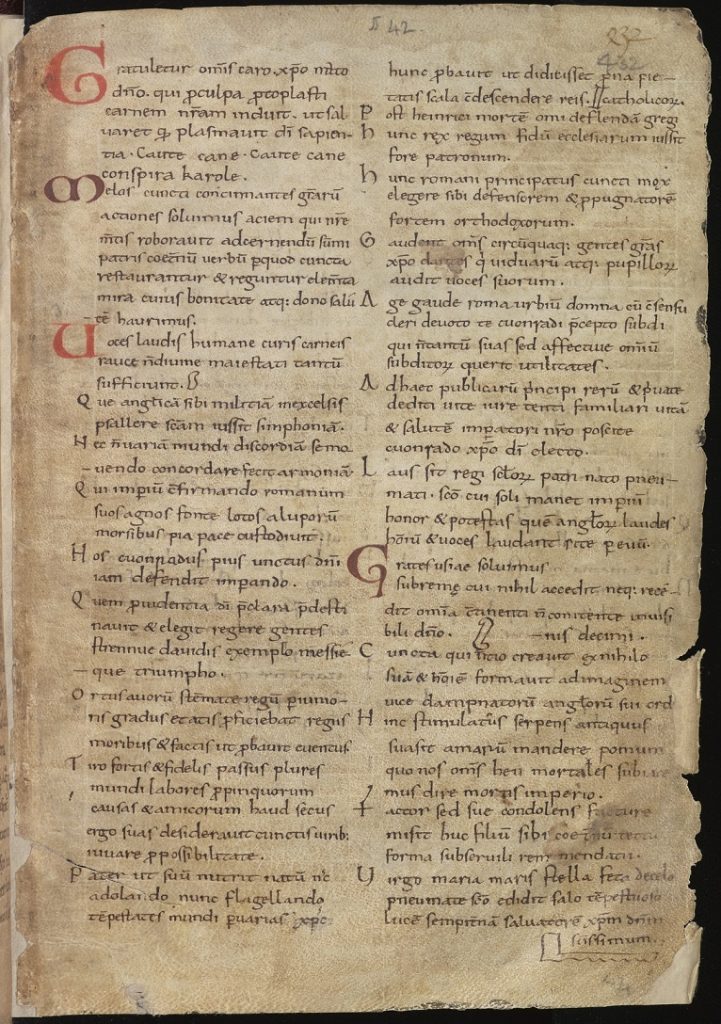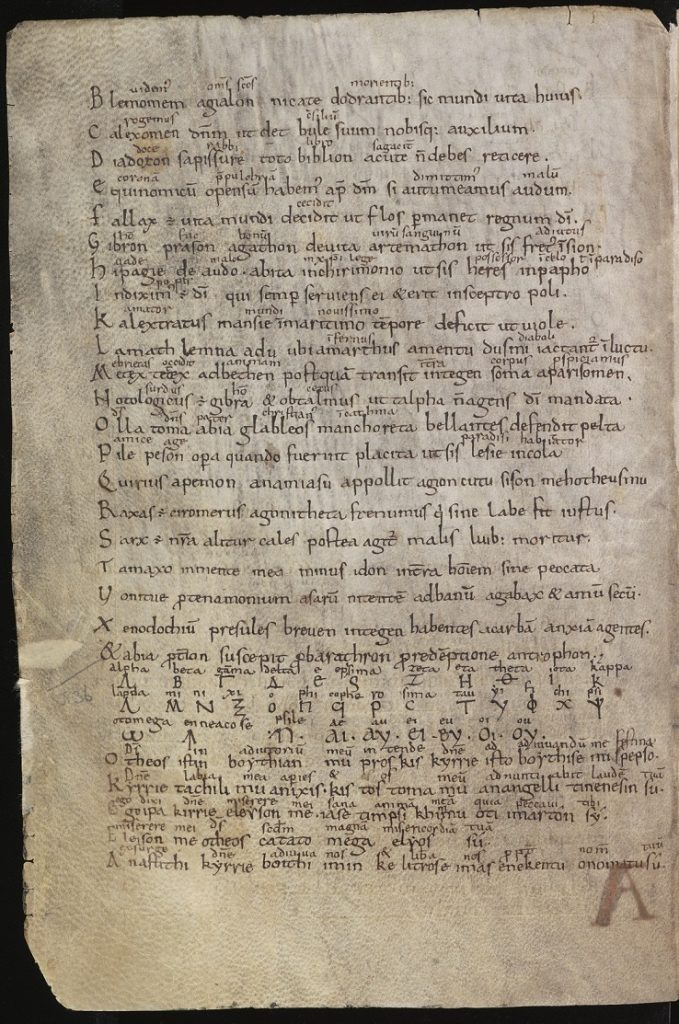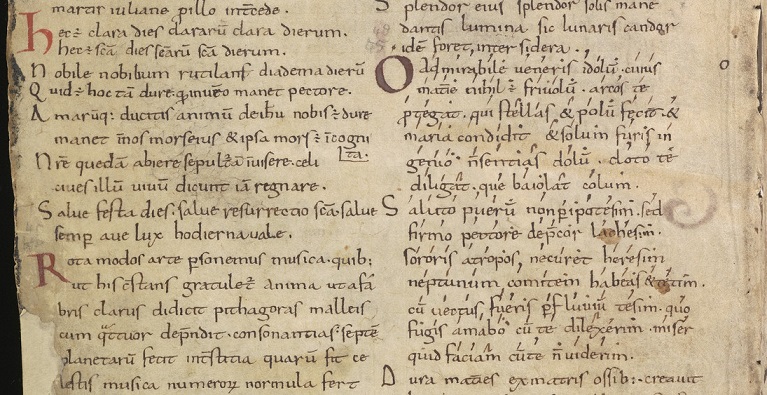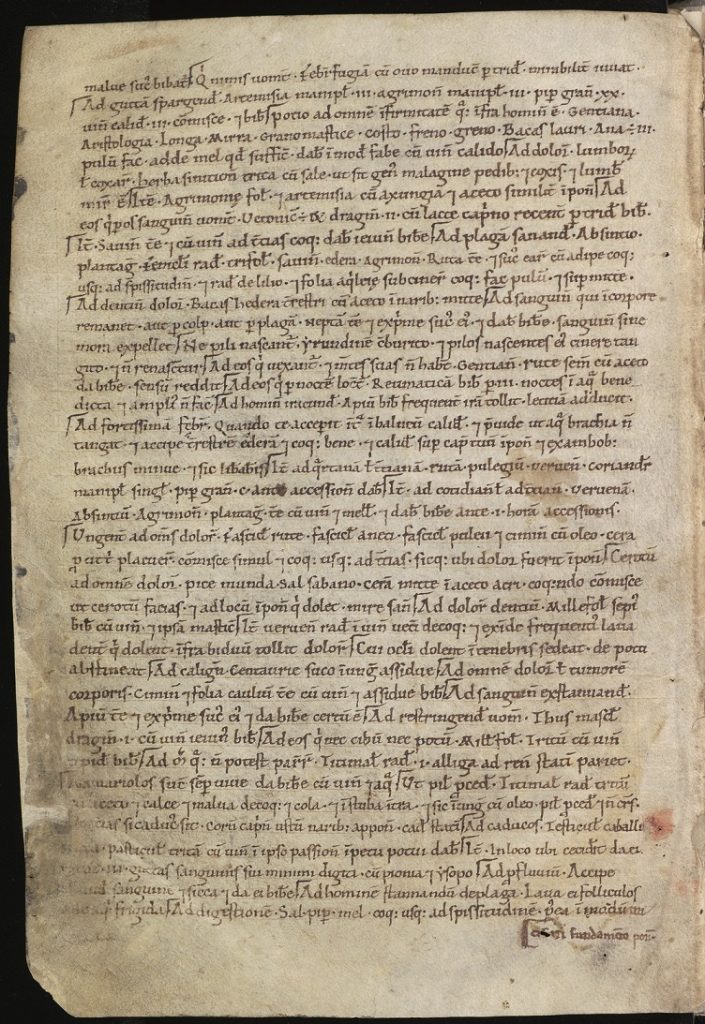A New Perspective on the Cambridge Songs Manuscript
This guest post is by Dr Claire Burridge, who completed her PhD at Cambridge (Sidney Sussex) in 2019 and currently holds a Leverhulme Trust Early Career Fellowship at the University of Sheffield. Broadly, she works on early medieval health and medicine and is interested in exploring the transmission of medical knowledge as well as the relationship between knowledge and practice. Her current project, ‘Crossroads: The Evolution of Early Medieval Medicine in Global and Local Contexts’, focuses on early medieval medical recipes – to find out more, check out her project website or follow her on Twitter at @ClaireBurridge3.
Background to the Cambridge Songs Manuscript, CUL MS Gg.5.35
The Cambridge Songs Manuscript, CUL MS Gg.5.35, is a wonderful enigma, acquired by the Library in 1672 using funds from the sale of duplicate books bequeathed by John Hacket (d. 1670), Bishop of Coventry and Lichfield. As its name might suggest, much scholarship has concentrated on the so-called ‘songs’ within this eleventh-century manuscript, a collection of forty-five texts near the very end of the codex (fols 432r-443v; see Figure 1). Most of these are poems and some of them have been set to music, hence the manuscript’s name. Intriguingly, despite the manuscript’s production in Canterbury in the years immediately preceding the Norman Conquest, many of these texts display a strikingly continental focus and, more specifically, point to connections between the Insular world and Ottonian and Salian dynasties, with poems celebrating, for example, German emperors and archbishops of the tenth and eleventh centuries.
At nearly 450 pages, however, the songs of the Songs Manuscript make up only a small part of the codex. The vast majority of this manuscript is dedicated to a variety of other poetic writings from classical and late antiquity, such as works by Sedulius, Arator, and Boethius, as well as material written by theologians of the early Middle Ages, including Hrabanus Maurus and Aldhelm. The manuscript also features riddles, a small number of texts in Greek (see Figure 2), examples of glosses in Old English, neumes (medieval musical notation; see Figure 3), and even two small sections of medical writings (see Figure 4). The latter, covering the final folios of the manuscript, fols. 422v-431v and 444v-446v, are spliced by the more famous songs. Despite the extensive scholarship concentrating on these songs, the surrounding medical texts have received much less attention. Yet, as a historian of early medieval health and medicine, it is this often-overlooked material that drew me to the codex.
The use(s) of a manuscript
Given the wide variety of texts contained within this manuscript, many scholars have been interested in establishing the context(s) in which it was used and the purpose(s) for which it was produced. Who were the intended readers or audience? Why was this mixture of writings copied together?
A number of theories have been put forward. On the one hand, it has been suggested that the manuscript was a florilegium (what today we could think of as a medieval scrapbook or textual ‘pick-and-mix’) compiled by a scribe with a particular interest in the topics on display, such as poetry. Alternatively, the presence of neumes might indicate that it was intended to be used in a musical setting. However, the appearance of glosses, integration of multiple languages, varied complexity of the poems, and overall diversity of texts seems to argue for a pedagogical purpose: it could have been used directly in teaching these topics or consulted as a reference work.
Still, these different possibilities tend to overlook or minimise the medical writings at the end of the manuscript – how does their presence affect our understanding of the book’s intended use(s)? While medical writings can be found in some surviving personal handbooks of Carolingian scholars, such as the vademecum of Walahfrid Strabo (cod. Sang. 878)—and often appear among a similar array of texts—the medical material in these contexts is generally much shorter, including, for example, individual remedies, dietary advice, or medical-calendrical guides. In contrast, the medical section of the Cambridge Songs Manuscript includes a recipe collection with over 200 individual prescriptions. While this information could have been used for teaching purposes or consulted as a general reference work (on medicine, the natural world, or even vocabulary and grammar), is it possible that it was used in the context of therapy as well?
Exploring the relationship between medical knowledge and practice
The emerging field of biocodicology, the study of the biological information contained within manuscripts, has revealed that investigating a manuscript’s biological record may be able to shed light on the relationship between medical knowledge and practice. The recent development of non-invasive spectroscopic and biomolecular sampling techniques is revolutionising the study of parchment and other materials used in production of manuscripts. Parchment analysis can not only provide insights into the physical material making up a manuscript (such as the identification of the animal species used for the parchment) but also offer information regarding its users and the environments in which it was used. As Cambridge researcher Sarah Fiddyment has demonstrated, these methods have major implications for the study of health and healing practices in the past. Dr Fiddyment’s recent work on an early modern parchment birthing girdle uncovered evidence of cervico-vaginal fluid on the surface of the parchment, confirming its use in the birthing process.
Returning to early medieval manuscripts, many pages of recipe collections and other medical texts, including some of those in the Cambridge Songs Manuscript, exhibit stains. Consider, for example, the brown smudge in the middle of the folio in Figure 4 or the small red stain in the bottom right corner. Could such marks relate to spills and splashes stemming from their use in a therapeutic setting, perhaps recording a drop of blood from a bloodletting procedure or an ingredient that was used in the preparation of a remedy? It may be helpful to reflect on a modern parallel: do your well-loved cookbooks bear signs of use in the kitchen – occasional (or frequent!) drips, drops, and stains?
By identifying substances that came into contact with the manuscript, an analysis of the surfaces of folios in the Cambridge Songs Manuscript offers a new perspective onto the question of how the manuscript was used. If there is evidence for any of the ingredients listed in remedies physically present on the parchment surfaces, it would strongly suggest that the codex was consulted in the context of therapy and used when preparing medications. To be clear, such findings would not rule out the many other ways in which the manuscript could have been used. Rather, this type of analysis has the potential to enrich our understanding of the entire manuscript and consider how the medical material relates to the whole.
Ultimately, interdisciplinary work connecting manuscript specialists, historians, and archaeologists has the potential to cast fresh light on complex topics. Perhaps I can write a future post on the fruits of this type of collaboration?! Stay tuned…




